PREVIOUS: Commercial
The Blue Ridge Parkway offers a variety of nature-oriented activities for the tourist migrating across the great road. Among these activities are camping, hiking , leaf-looking, and an incredible variety of flora and fauna for naturalists to observe. Such activities are in line with the original vision of the BRP as, first and foremost, a scenic parkway. Signs, advertisements, and commercial buildings are noticeably absent along the Parkway. This is intentional, to insure the beautiful scenery and nature remain undisturbed.
Camping
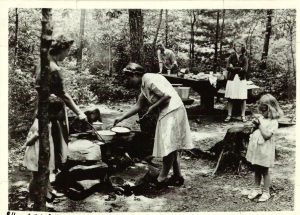
Cumberland Knob Picnic Group. Photo Courtesy of the Blue Ridge Parkway Archives. [3]
There is no better window to nature than camping. Camping has long been one of the greatest and most widely enjoyed activities in national parks, and the
BRP is no exception. Camping is quite a popular past time along the Blue Ridge Parkway, along with other activities that come along with camping, such as campfires, hiking, picnicking, and more. There are currently eight campgrounds that are located on the Parkway. These campgrounds, five of which are located in North Carolina, are $20 per night and are open May-October (weather permitting) and have water, restroom facilities, dump stations for trash, and fire pits. Some campgrounds even offer interpretive talks by rangers at amphitheaters located on the grounds.
[1] This particular activity helps tourists learn more about the area, the history of the Parkway, and the local color that the
BRP has worked so hard to preserve. The campgrounds, like much of the Parkway, are typically closed in the winter and as a result of bad weather.
[2] Since the Parkway runs hundreds of miles through the Blue Ridge Mountains, it is in an ideal position to offer plenty of camping options. For the nature lover, the
BRP is the perfect place for camping.
Hiking
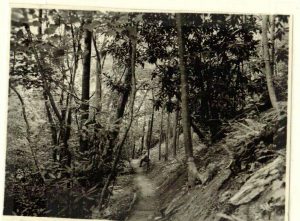
Cumberland Knob Trail. Photo Courtesy of the Blue Ridge Parkway Photo Library. [6]
As far as natural outdoor activities go, hiking ranks high on visitor to-do-list while visiting the Parkway. The BRP boasts 72 hiking trails in North Carolina alone. These trails range from .05 miles to over 13 miles and are anywhere from easy to strenuous.
[4] By providing a variety of trails at varying lengths and ranges of difficulty, the Parkway attracts many different types of tourists, from those out for a leisurely day to those looking for a more vigorous workout. Along these trails hikers may view waterfalls, wildflowers, meadows, and incredible views of the surrounding mountains.
[5] The Parkway also crosses paths with the Appalachian Mountain-to-Sea Trail (AT). This particular hike runs almost 1,200 miles and invites the true Outdoors person to experience a deep connection with nature.The AT can be hiked in portions or as a whole, requiring the hiker to camp along the trail. The NPS encourages hiking by including a list of the most popular trails along the Parkway as well as helpful tips for potential hikers.
[7] Some of the most popular hikes on or near the Parkway include Craggy Gardens, Crabtree Meadows, Linville Falls, Mount Mitchell, Mount Pisgah, and Grandfather Mountain. For the nature enthusiast, hiking on the Blue Ridge Parkway is a must.
Leaf-Looking
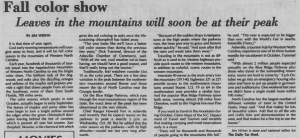
Autumn Colors on the Parkway.[8]
Any
WNC resident can attest to the high volume of tourists during October. This migration of visitors is largely the product on one particular activity: leaf-looking. In Autumn, the Blue Ridge Mountains looses its typical hazy blue appearance, exchanging it for rich golds, vibrant oranges, and deep reds—a true feast for the eyes! Leaf-looking is one of the most popular attractions of the Blue Ridge Mountains. The Parkway in particular has long been known as a treasure during Autumn.
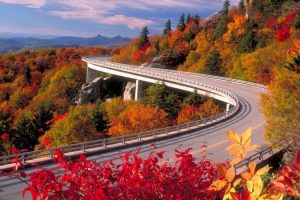
Linn Cove Viaduct. Photo Courtesy of the Blue Ridge Parkway Daily. [10]
Offering a variety of peaks and vistas and valleys washed in the yellow, orange, and red glow of Fall, the Parkway also has a longer leaf season than many other places, ensuring visitors have a much wider window of opportunity to see the leaves change. This is due in part to the variance in altitude. Leaves at higher elevations change first while trees at lower elevations finish up the colorful mountain show. Winding through the mountains at an altitude of between 650 and 6,000 feet, the
BRP provides the perfect opportunity to view the spectacular Fall colors.
[9] This activity alone attracts hundreds, perhaps thousands, of visitors each year to the Parkway. Leaf season is also prime time for hiking on the Parkway. The temperate climate and crisp Autumn air lures many a visitor.
For the Naturalist
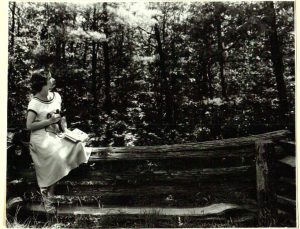
Bird Watching. Photo Courtesy of the Blue Ridge Parkway Archives. [12]
The deep forests of the Blue Ridge Mountains, offering an almost mystic quality for its visitors, is a wilderness utopia.The plant and wildlife along the Parkway is positively tremendous in its diversity. Offering 1,600 types of vascular plants, 137 types of trees, 74 species of mammals, 115 kinds of nesting birds, over 40 varieties of amphibians, and 35 species of reptiles, the
BRP is a natural wonderland.
[11]
The Parkway certainly provides an array of flora and fauna for the naturalist to observe! In this regards, the
BRP is immensely treasured by both
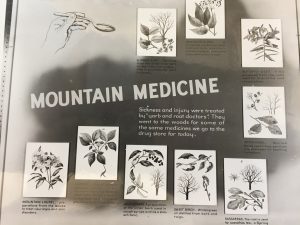
Mountain Medicine. Photo Courtesy of the Blue Ridge Parkway Archives. [13]
locals and tourists alike who wish to catch nature at its finest. “Mountain Medicine” has also drawn naturalists to the region. Traditional usage of plants and herbs to treat various ailments is deeply rooted in both Appalachian culture as well as Cherokee culture. As a gateway to mountain wilderness, the Blue Ridge Parkway recognized the access it gave visitors to these plants and helped naturalists to identify medicinal flora. Not only does Appalachian herbology appeal to naturalists, it also provides tourists with a unique view inside local culture and historic memory. This sort of appeal is important as it not only highlights the central role of nature an the forest in WNC, but also helps keep local memory alive.
UP NEXT: About Us
[1] “Camping on the Blue Ridge Parkway,” National Parks Traveler, accessed November 15, 2017, https://www.nationalparkstraveler.org/parks/blue-ridge-parkway/camping-blue-ridge-parkway.
[2] “Camping,” National Parks Service, April 20, 2017, accessed October 31, 2017, https://www.nps.gov/blri/planyourvisit/camping.htm.
[3] Cumberland Knob Picnic Group, Cumberland Knob, milepost 217.6, photographer Rowe, June 1946, Blue Ridge Parkway Photo Library, Blue Ridge Parkway Headquarters, Asheville, North Carolina.
[4] “North Carolina Hiking Trails along the Blue Ridge Parkway,” North Carolina Hiking Trails along the Blue Ridge Parkway – Blue Ridge Parkway, accessed October 31, 2017, http://www.blueridgeparkway.org/v.php?pg=61.
[5] “North Carolina Hiking Trails,” National Parks Service, December 8, 2016, accessed October 31, 2017 https://www.nps.gov/blri/planyourvisit/nc-trails.htm.
[6] Hiking Trail, Cumberland Knob Park, Sec. 2A, milepost 217.5, photographer ASB, August 1936, Blue Ridge Parkway Photo Library, Blue Ridge Parkway Headquarters, Asheville, North Carolina.
[7] “Hiking,” National Parks Service, November 30, 2016, accessed October 31, 2017, https://www.nps.gov/blri/planyourvisit/hiking.htm.
[8] Jim Wrinn, “Fall Colors Show: Leaves in the mountains will soon be at their peak,” Daily Tar Heel, September 30, 1982, accessed October 6, 2017, https://www.newspapers.com/clip/14233855/the_daily_tar_heel/.
[9] “Fall Color – Tips for Leaf Season,” Fall Color – Tips for Leaf Season – Blue Ridge Parkway, accessed October 31, 2017, http://www.blueridgeparkway.org/v.php?pg=286.
[10] Linn Cove Viaduct, digital image, BlueRige Parkway Daily, accessed November 26, 2017, http://www.blueridgeparkwaydaily.com/enjoy-view-watch-road-blue-ridge-parkway-prepares-fall-travel-season/.
[11] “More than Just a Road: Protecting Parkway Viewsheds,” Blue Ridge Parkway Directory and Travel Planner: Celebrating 75 Years, 61st Edition, Blue Ridge Parkway Association, 2010, Ephemera, Blue Ridge Parkway Archives, Asheville, North Carolina, 14.
[12] Bird Watching at Fox Hunters Paradise, Fox Hunters Paradise, milepost 218.6, photographer Fawcett, 1950, Blue Ridge Parkway Photo Library, Blue Ridge Parkway Headquarters, Asheville, North Carolina.
[13] Mountain Medicine, Unlabeled Box, No Provenance, Blue Ridge Parkway Archives, Asheville, North Carolina.






